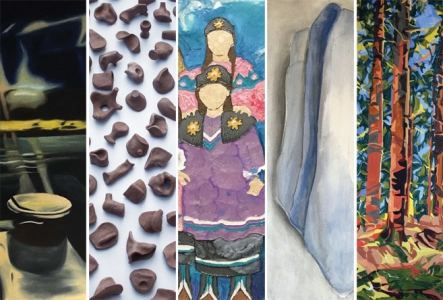Past Exhibition
The Stories We Share, The Tales We Tell
Group Show
__ __ __
November 2017
The Stories We Share, The Tales We Tell presents the work of five alumni who recently graduated from Sheridan College’s Visual and Creative Arts program in Oakville. Catherine Beaver, Valentin Brown, Tania Costa, Linsey Cull and Samantha Hamilton work in various mediums and styles but share an interest in harvesting their own personal experiences.
The social conventions that designate the public and private are ever-changing, as are the expectations to share cultural and personal knowledge. In this delicate balance between maintaining one’s own privacy and making the personal public, the emerging artists in this exhibition distort, veil, and/or withhold their personal experience and knowledge yet share enough to prompt a wider conversation. Despite the pressure to bare all, they radically keep something for themselves, or from the viewer, while also provoking dialogue about the broader issues facing Canadians today. By using vague titles, amorphous shapes or images that withhold the identities of the persons portrayed, entire lifeways are camouflaged in clay, colour, and stone. This exhibition not only considers what stories are shared but also how they are told: with care.
Catherine Beaver is from the Nation Tuscarora and is Turtle Clan from the Six Nations of the Grand River. The three series on view tell the story of her childhood from different vantage points and in multiple styles. Each untitled series contains coded information, and with each style, Beaver shares specific knowledge and experiences with a different audience. The figures in her multi-media works, made from fantasy paint and gel outliner, take their inspiration from the story of the cornhusk doll. Women and children stand tall in their regalia, faceless and protected from view. In another series that is realistically rendered in acrylic paint, Beaver not only depicts her father but the land that is, according to the artist, “always there, beautiful, nourishing and full of stories.” The final series is sculptural. A school of concrete and aluminum fish lie atop one another in formation on the floor of the gallery. Looking up at the viewer are not little fishy faces, but human faces. These hybrid creatures call attention to Indigenous hunting and fishing rights that remain at risk, even today. With each series, Beaver shares different aspects of her position as an Indigenous woman in Canada.
Valentin Brown has cared for each of the 261 automatic sculptures that make up Unidentified Remains. Individually sanded, the smooth, unfired, clay pieces have been gently tended to by the artist. Calling to mind tales of the human and inhuman, individual and collective, contemporary and prehistoric, these indiscernible objects never rest on a singular form, refusing to give away their identities. With this act of queering, Brown ever-so-slightly hints at the vast spectrum of gender and the plasticity of identity. As a self-identified, gender/queer artist, Brown seeks out the space that is neither here nor there and those things which are neither this nor that. Their work rests in-between, simultaneously inhabiting both and neither.
Tania Costa paints what is for her the wild landscape beyond her urban home. Patches of bright colours dress the trees, causing her forest-scapes to take on the appearance of camouflage. The personal sentiments, passions, and whims that Costa uses to inform her colour choices and placement are also camouflaged within the paintings. Blocks of blues, yellows, greens, greys, browns, and oranges spread across her canvases, creating an unnaturally flat environment that contradicts her dynamic and wild subject matter. From this contradiction a host of questions erupt. Just what separates the natural, wild environments from the artificial or human-made? Can the urban landscape be home to wilderness? Can the rural landscape?
Linsey Cull tells the tales of her hometown Sudbury, Ontario through the objects that grace its landscape. Using watercolour, Cull has painted the portraits of two solitary stones. Stone I and Stone II transport the viewer into her personal narrative. These objects are painted from a bird’s-eye view, and this tactic puts the viewer in Cull’s place along the Canadian Shield shorelines where she once looked down at the very same stones. She centres these objects on blank paper, leaving all other details to the imagination. By removing the context and any other visual cues, she asks us to consider our own relation to the land and the objects that inhabit it.
The delicate balance between public and private, between what to share and what to keep hidden, is most apparent in Samantha Hamilton’s series “Memories.” Her paintings take on the appearance of widescreen movies, photographs, or reflections in a window. The spaces portrayed are blurred, and the faces painted are censored. In some instances, the faces are so large that only portions of them are made to fit the canvas, or the eyes of the subjects are covered with black bars. In other cases, there are minute water droplets painted onto the canvas, as if one was looking out through the window of a car on a rainy day. With these strategies, Hamilton protects the anonymity of her profoundly personal subjects, spaces, and stories making the viewer aware of their gaze, while simultaneously encouraging the viewer to place themselves in the role of the subject. Despite wanting to connect with others and to share that which she holds dear, her work prompts the question: is it truly possible to share things as we have experienced them?
The works in this exhibition are driven by a care that is not indulgent and that does not dote, but rather, by a sustaining care that preserves and protects oneself, one’s community and the environment. The emerging artists share stories and tell tales by leveraging their privacy against our public consumption ultimately asking us: What stories matter? And to whom? - Jaclyn Quaresma
With special thanks to Corinne Duchesne and David Joron, Full Time Faculty Visual and Creative Arts Program Sheridan College, and Brad Sherwood, VCA technician at Sheridan.

